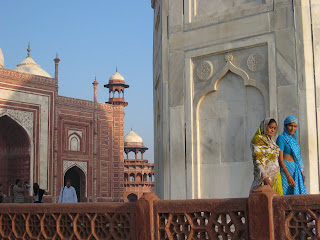Many backpackers - myself included - have an uneasy relationship with "The Book"... I try to keep ours under wraps, consulting under the table. "I don;t really use it - just for the maps" or "the history section's alright 'cause it's short" is the slightly guilty excuse I often hear (sometimes from my own lips!). Everyone wants to believe they're discovering something for the first time, and if you do happen to, well, just "stumble" upon an LP reviewed restaurant or guesthouse, it's inevitably doubled in price, halved in quality, or generally crap, the result of a "resting on laurels" attitude, an unmanageable growth spurt or simple greed.
These places have been Planeted, and we try to avoid them, along with their self congratulatory guest books and homesick menus of mashed potato, pizza and Israeli salad.
But when the L.P. gives advice on how to handle beggars, I take it. When it advises on an ethical charity group or not-for-profit enterprise, I believe it to be true. And when the section on Jaisalmer suggested that development in the Old Fort was becoming unsustainable and that it might be a wise choice to stay outside the rapidly subsiding sandstone walls, I did exactly that. My faith in the ethics of The Book remains, but the people who have inhabited Jaisalmer's captivating landmark for centuries, and have made a killing from tourism for the last 15 years, are very, very cranky. The number one question became not "where you from", but "where you stay?" - are you an innie or an outie? Do you have THAT book? Do you know they make us unemployed, they want to take our jobs, they tell lies to tourists. There are even placards around the fort, protesting against the guidebook's recommendation. Meanwhile, excessive water use saturates the stone, and walls collapse, most recently killing 10 (but mostly rickshaw drivers, so questionable loss). The local government installs a cosmetic underground sewerage system with narrow pipes, and now the blockages and leaks that were once the responsibility of each household are out of sight, unmaintainable. Yet this is not a problem of government, it seems, or of personal greed. Responsibility is laid squarely at those nasty slanderous writers of the travel bible.
For these isolated but newly wealthy tourism operators, 15 years makes them feel like veterans. Coming from China, I'vw seen exactly how excessive tourism can destroy the soul of a city, but also how government management of infrastructure can turn a humble village into a Disney style gold mine very successfully. I hope neither of these things happens in Jaisalmer, but it certainly won't be up to a guidebook to decide.
(me at one of the resturants withing the walls of the fort... it may or may not have been in the LP)




























